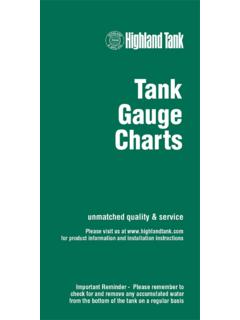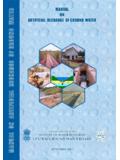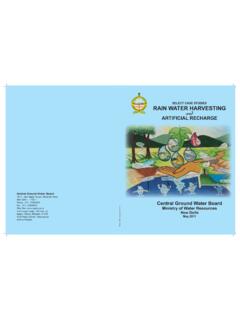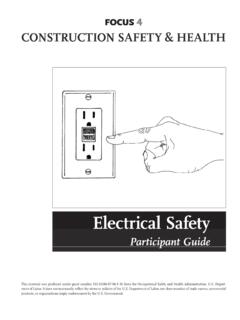Transcription of Oil/Water Separators Sizing Guide - Highland Tank
1 Oil/Water Separators Sizing Guide For your convenience, Highland Tank's Oil/Water separator (OWS) Sizing utilities are available on-line at This Guide is intended to assist knowledgeable personnel with Sizing a Highland Tank Oil/Water separator . The information contained herein is the opinion of Highland Tank. Individual projects must be evaluated to determine the appropriate size and configuration for that site. When Sizing an OWS, there are three primary factors to consider: 1 - Treatment Flow-Rate, 2 - Spill Capacity, 3 - All applicable Codes & Regulations.
2 1 Treatment Flow-Rate Contaminated flows generally generate from two primary sources - intermittent flows from normal hose- down or industrial process operations and stormwater runoff. Stormwater runoff flows usually greatly exceed all other flows. The design flow for an OWS should be based on the maximum total flow rates projected for treatment of contaminated flow at any given time. 2 Spill Capacity Highland Tank recommends OWS have accumulated wastes removed when their volume reaches 20% of static vessel volume. It is important to monitor this level to determine what the spill containment capacity is on a continual basis.
3 Highland Tank OWS have a high-oil capacity equal to 43% of the static vessel volume. This capacity is considered the maximum operational level. Once this volume is exceeded, effluent quality may degrade. Highland Tank OWS have a spill capacity equal to 80% of the static vessel volume. This capacity considers containment of a pure oil spill only. After determining the largest spill potential for the project, consider selecting a larger volume OWS. accordingly to accommodate for spills. 3 Applicable Codes & Regulations Highland Tank recommends checking with the authority having jurisdiction for your project's location to determine any affect on design, operation and Sizing of the OWS.
4 Federal and State regulatory information is available at To select the correct OWS volume, review the three factors above again to determine which one will have the most impact as they relate to your project. Only qualified personnel should make this determination. Contact Highland Tank for assistance with determining the controlling factor. If spill capacity or regulations dictate Sizing requirements, continue to the appropriate schedule of sizes for your installation application. To determine if stormwater runoff or service areas dictate Sizing requirements, continue with the surface area calculators below to help determine OWS Sizing .
5 Highland Tank HT-9064 10/2018. Outdoor Applications: Determine Stormwater Generation by Calculating Runoff The initial step for computing a design flow is to define the areas where contaminated flow will originate. A map and description of the facility will help identify the areas where oily water is being generated. The treatment area should include any areas where contamination by accidental spills of oils, greases, fuels or other petroleum hydrocarbon products onto the ground may occur. A separate drainage system to serve these affected areas should be considered.
6 Highland Tank recommends that all other areas drain through a separate system to minimize the size of the OWS. Site elevations may require the use of multiple OWS or pumping of the stormwater for treatment. Should multiple units be selected, each separate drainage area must be reviewed. Determine the area from which oily stormwater runoff can be expected. Calculate area in square feet from measurements or drawings and record here _____(A). Using the rainfall chart, identify the amount of rain expected to fall in a one-hour period in the area of your facility and record it here _____(R).
7 NOTE: This chart is based on a 10-year, 1-hour rainfall event. The project's designer shall determine if this scenario meets the need of the project or if the application of a different storm event is appropriate. Highland Tank HT-9064 10/2018. Calculate treatment flow rate The formula to determine the treatment flow rate (TFR) in gallons per minute (GPM) is: A x R x = TFR. Example: One acre (43,560 ft2) in south-central Pennsylvania. 43,560 x 2 x = GPM. OR. Indoor Applications: Vehicle Service Bay Drainage The initial step for computing a design flow is to identify the areas where contaminated flow will originate.
8 The treatment area should include any areas where contamination from vehicle washing operations, accidental spills of oils, greases, fuels or other petroleum hydrocarbon products onto the floor may occur, as well as any industrial processes that will feed wastewater into the OWS. Determine the total flow from which oily runoff can be expected. All sources of water that will drain into the OWS must be considered to ensure under- Sizing the OWS. Maximum flow rates from all wastewater- producing operations should be added together for determining an appropriate size OWS for your project.
9 When installed for wastewater treatment from indoor service or process operations, the OWS must be installed in accordance with all plumbing codes in effect for the installation location. International Building Code, for example, requires 6 ft3 of volume for the first 100 ft2 of indoor floor area and 1 ft3 of volume for each 100 ft2 of floor area thereafter. In this case, the following formula can be used: ( 2 ). [ +% . 7 ] . = Required Nominal Gallonage Example: 10,000 ft2. [ 6 + (10,000-100) / 100) ] = x = 119 Gallons Select OWS from Schedules The following schedules represent capacities for Highland Tank's STANDARD OWS models.
10 If your project dictates the use of any special treatment ( flow rate, spill or storage capacity, special chambers, etc.), please contact Highland Tank for assistance with customization. Based on the Sizing method and information determined above, select the correct size OWS from the Sizing charts below. To provide an additional safety margin, consider selecting the next high volume unit. Custom Sizing is available. Highland manufactures OWSs with effluent rates down to as low as the 10-ppm discharge and filtration systems to further improve effluent discharge.











